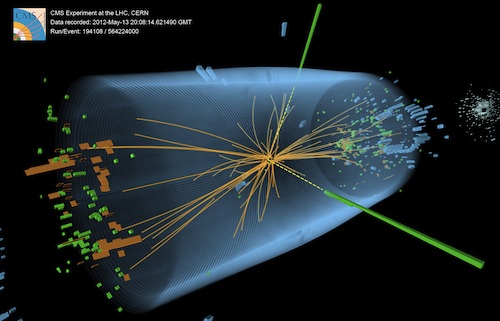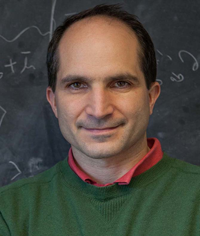This article is part of the Finance and physics package. Click here to see the previous article in the series.
The mechanism described in the previous article gives a mass to the mediators of the weak force, but it does not explain why there should be a new physical particle, such as the Higgs boson. Let us explain this through the economic analogy. We can fix the price of gold to 1 everywhere by a currency (or gauge) transformation. Once this is done, the only remaining variables are the exchange rates. In physics this gives rise to a massive particle, but to no other particle. In classical physics, this theory is works perfectly and we don't need an extra particle. However, in the quantum mechanical version this is not the case, especially in the case of the weak force.
In one of the previous articles we talked about the fact that, in order for the theory to work, we need to take a continuum limit — we start by assuming that spacetime has a discrete structure, and the "zoom out" until the grid appears to be a continuum.

Here we display the grid of countries at various scales. We are zooming out as we move to the right. If we zoom out sufficiently we can view the whole grid as a continuum.
The quantum mechanical version of the continuum limit is very subtle. A detailed analysis reveals that a theory without extra particles would not permit the weak force mediators to have a mass which stays fixed as we take the spacing between the countries to zero. Their mass would go to infinity as we take the continuum limit in the quantum theory. It turns out that this problem goes away when you assume the existence of extra particles. For this reason everybody expected that the Large Hadron Collider would discover new particles. The simplest possibility was to add just one new particle. Indeed this extra particle was discovered at the Large Hadron Collider in 2012.
In the economic analogy these new particles arise when we have more goods that we can carry between the different countries. For example we can also have silver. Silver also has a price in each country, again chosen arbitrarily by the inhabitants of each country. Now, in each country, the ratio between the price of gold and silver is independent of the currency units, it is gauge invariant. If one ounce of gold costs 2,000 pesos and one ounce of silver costs 1,000 pesos, then we can say that gold is twice more expensive than silver. If we change currencies to Australes, the price of gold is 2 Australes and that of silver is 1 Austral. But gold is still twice more expensive than silver.

An event recorded by the CMS detector in CERN in 2012 showing the characteristics expected from a Higgs boson decaying into two photons. (Image CMS)
Therefore, in this situation, we have a quantity that is defined in each country which is independent of the choice of currency: the ratio of the value of gold and the value of silver. In physics this corresponds to a field that gives rise to a physical particle. This is the field associated to the actual physical Higgs boson particle. Note that in the case that we only had gold, we also have a quantity defined in each country, which is the price of gold. However, this quantity depends on the choice of currency. Quantities that depend on the currency units do not reflect real economic opportunities. In physics they are not observable. In fact, we have seen that through a gauge transformation (or currency transformation) we can set the price of gold to one everywhere, so that it disappears as a physical field. However, with both gold and silver we have now a physical field.
Let us emphasise this point once more. Only quantities that are gauge invariant are regarded as meaninful. For example, what is important is not the price of a banana, but the price of the banana divided by your salary. Both the price of the banana and your salary can change if there is change of currency units, but this ratio does not change. In physics, especially in quantum physics, we do not view gauge symmetry as a physical symmetry, rather as a convenient tool for the description of the system which is not fundamental. In fact, there are examples of theories based on different gauge symmetries which are quantum mechanically equivalent.
Though we have not attempted to give the history of these concepts, we cannot resist making a few historical comments. Yang and Mills invented the Yang Mills theory to describe particles called mesons. However, we currently use it to describe weak and also the strong nuclear forces. This is an example where a good idea was not useful for its original purpose but was useful for other problems. Though Pauli's objection was right, it was not a fatal flaw. It could be fixed in a relatively simple way. The mathematics of gauge theories was discovered before by mathematicians who know these structures as fiber bundles.
Inspired by many previous experiments and partial results, the theory of electromagnetism and the weak force was written first by Steven Weinberg, with important contributions by Sheldon Lee Glashow, Abdus Salam ans several other physicists. Later experiments confirmed this theory and ruled out competing alternatives. The most important current experiment in particle physics is going on at the Large Hadron Collider in Europe. [what's that?]
Notice the simplicity of physics relative to economics. In economics there are many things that we can trade, not just gold and silver. We can also trade among all the countries at the same time. In physics we can trade only with the neighbours. Importantly in physics we take the continuum limit, which greatly simplifies the mathematical structure that exists at long distances. For these reasons the gauge principle in economics is far less constraining than it is in physics.
It is worth noting that Weinberg's paper is just three pages long, while here it has taken us many more pages to give a still imprecise explanation. This is an example of the power of formulas. It is often said that a picture is worth a thousand words. A formula is worth a million pictures!
Previous article: The Higgs mechanism. You can also see the Mathematical appendix (in pdf format).
Back to the Finance and physics package
These articles contribute to our Stuff happens: The physics of events project.
About the author

Juan Maldacena is the Carl Feinberg professor at the Institute for Advanced Study at Princeton, New Jersey, USA. He works on quantum field theory and quantum gravity and has proposed a connection between those two (see this article).